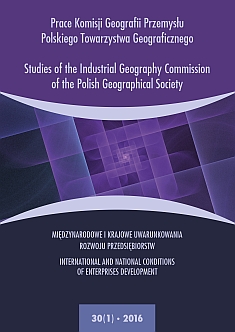Kraje Europy Środkowo-Wschodniej wobec ekspansji chińskiej gospodarki
Słowa kluczowe:
Chiny, Europa Środkowo-Wschodnia, nowy jedwabny szlak, 16 1Abstrakt
Chiny stają się obecnie jednym z najważniejszych państw w światowej gospodarce. Bardzo szybki rozwój chińskiej gospodarki powoduje znaczące zmiany zarówno w sprawach wewnętrznych, jak i w zagranicznych działaniach Chińskiej Republiki Ludowej (ChRL). Jednym z najważniejszych obszarów międzynarodowej aktywności Państwa Środka są zwiększające się z roku na rok bezpośrednie inwestycje zagraniczne. Europa Środkowo-Wschodnia jest regionem, który dopiero w ostatnich latach przyciągnął uwagę Pekinu. W niniejszej pracy za kraje Europy Środkowo- -Wschodniej uznano: Estonię, Litwę, Łotwę, Polskę, Czechy, Słowację, Węgry, Słowenię, Rumunię, Chorwację, Serbię, Bośnię i Hercegowinę, Czarnogórę, Bułgarię, Macedonię, Albanię. Od 2011 roku mamy do czynienia z ożywioną współpracą polityczną pomiędzy wyżej wymienionymi państwami i Chinami. Najważniejszym elementem tej współpracy są coroczne spotkania szefów wszystkich państw biorących udział w inicjatywie 16 + 1. Ważnym aspektem współpracy może być również koncepcja nowego jedwabnego szlaku, która jest szeroko promowana przez chińskie władze. Celem niniejszego artykułu jest zbadanie przestrzennego zróżnicowania relacji łączących Chiny oraz kraje Europy Środkowo-Wschodniej. Za istotne uznano m.in. wymianę handlową oraz napływ chińskich inwestycji. Wyniki badań wskazują na najwyższą wartość wymiany handlowej Chin z Polską oraz Czechami. Zdecydowanie największe inwestycje ulokowane zostały na Węgrzech. Można również zauważyć, iż Chińczycy zawarli wiele kontraktów na projekty infrastrukturalne z krajami bałkańskimi, co może być spowodowane realizacją koncepcji nowego jedwabnego szlaku.
Downloads
Metrics
Bibliografia
Bolesta, A. (2006). Chiny w okresie transformacji. Warszawa: Wydawnictwo Akademickie Dialog.
China Global Investment Tracker (2015, 30 listopada). American Enterprise Institute. Pozyskano z https://www.aei.org/china-global-investment-tracker/
Dixon, C. (2015). The New BRICS Bank: Challenging the International Financial Order? GPI Policy Paper, 28.
Dumitrescu, G.K. (2015). Central and Eastern European Countries Focus on the Silk Road Economic Belt. W: Global Economic Observer, 3(1), 186–197.
Garnaut, R., Song, L., Fang, C., Johnston, L. (red.) (2015). China’s domestic transformation in a global context. Australia: ANU Press.
Góralczyk, B. (2015, 18 października). Dyplomacja pieniądza. Obserwator finansowy. Pozyskano z http://www.obserwatorfinansowy.pl/tematyka/makroekonomia/dyplomacja-pieniadza/
Jakubowski, J. (2015, 30 października). Złe perspektywy gospodarcze utrudnią chińskie reformy. Ośrodek Studiów Wschodnich. Pozyskano z http://www.osw.waw.pl/pl/publikacje/analizy/ 2015-08-26/zle-perspektywy-gospodarcze-utrudnia-chinskie-reformy
Johnston, M. (2015, 22 października). China’s Economy: Transition to Sustainable Growth. Investopedia. Pozyskano z http://www.investopedia.com/articles/forex/091115/chinas-economy- -transition-sustainable-growth.asp?layout=infini&v=1B
Kaczmarski, M. (2015). Nowy Jedwabny Szlak: uniwersalne narzędzie chińskiej polityki. Komentarze Ośrodka Studiów Wschodnich, 161.
Kaczmarski, M., Jakubowski, J. (2015). Chiny – Europa Środkowo-Wschodnia: „16 + 1” widziane z Pekinu. Komentarze Ośrodka Studiów Wschodnich, 166.
Kissinger, H. (2014). O Chinach. Wołowiec: Wydawnictwo Czarne.
Knoerich, J. (2015, 15 października). China’s AIIB Dream. China Policy Institute Blog. Pozyskano z https://blogs.nottingham.ac.uk/chinapolicyinstitute/2015/06/03/chinas-aiib-dream/ Liang, S., Garnaut, R., Cai, F. (2014). Deepening Reform for China’s Long-term Growth and Development. Australia: ANU Press.
Liberska, B. (2010). Perspektywy rozwojowe chińskiej gospodarki do 2050 roku. W: Studia Ekonomiczne, 4, 331–358.
Liu, Z. (2013). The Pragmatic Cooperation between China and CEE: Characteristics, Problems, and Policy Suggestions. W: Working Papers Series on European Studies, 7(6). Pekin: Institute of European Studies, Chinese Academy of Social Sciences, 1–9.
Liu, Z. (2014). Central and Eastern Europe in Building the Silk Road Economic Belt. W: Working Papers Series on European Studies, 8(3). Pekin: Institute of European Studies, Chinese Academy of Social Sciences, 1–12.
Mitrović, D. (2014). China in the Western East – and Beyond: Politics and Economics of the China Plus Sixteen Cooperation Framework. W: Serbian Political Thought, 2. Belgrad: Institute for Political Studies, 19–50.
Renard, T. (2015). The Asian Infrastructure Investment Bank (AIIB): China’s new multilateralism and the erosion of the West. W: Security Policy Brief, 63. Egmont: The Royal Institute for International Relations, 1–7.
Shambaugh, D. (2013). China Goes Global: The Partial Power. Nowy Jork: Oxford University Press.
Song, L. (2013). From rediscovery to new cooperation: the relationship between China and Central and Eastern Europe. W: J. Men (red.). EU-China Observer, 5. Bruges: College of Europe, 8–14.
The State Council Information Office Holds a Press Conference on Statistical Communiqué of 2014 on China Direct Investment Overseas (2015, 8 paździenika). Ministry of Commerce People’s Republic of China (MOFCOM). Pozyskano z http://english.mofcom.gov.cn/article/newsrelease/ press/201509/20150901124461.shtml
Trailović, D., Kiculović, B. (2014). Economic and political implications of Chinese engagement in Central and Eastern European Countries. W: S. Scaunas, E. Strautiu, V. Tabara (red.). Political Science, International Relations and Security Studies. Sibiu: Lucian Blaga University of Sibiu, 196–203.
Turcsányi, R., Qiaoan, R., Kříž, Z. (2014). Coming From Nowhere: The Chinese Perception of the Concept of Central Europe. W: D. Mierzejewski (red.). The Quandaries of China’s Domestic and Foreign Development. Łódź: Wydawnictwo Uniwersytetu Łódzkiego, 155–171.
Vangeli, A. (2015, 30 września). The new kid in the block: a short intro to the China-WB relationship.Balkans in Europe Policy Blog. Pozyskano z http://www.suedosteuropa.uni-graz.at/biepag/ node/138
Żmuda, M. (2009). Przyczyny wejścia chińskiej republiki ludowej na ścieżkę przyspieszonego wzrostu gospodarczego. W: W. Michalczyk (red.). Wybrane problemy gospodarki światowej pierwszej dekady nowego wieku. Wrocław: Uniwersytet Ekonomiczny we Wrocławiu, Katedra Międzynarodowych Stosunków Gospodarczych, 93–101.
Pobrania
Opublikowane
Jak cytować
Numer
Dział
Licencja
Artykuły publikowane są zgodnie z warunkami licencji Creative Commons (CC BY-ND 4.0; uznanie autorstwa-bez utworów zależnych).

